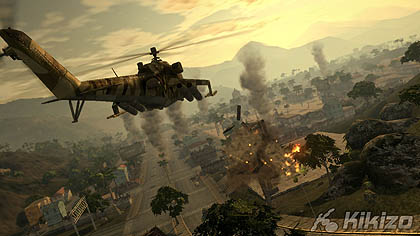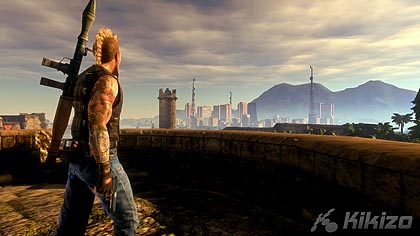Mercenaries 2: World in Flames
Is blowing stuff up in Pandemic's sequel a one trick pony?
| Version 360, PS3, PC | Developer EA Pandemic | Publisher EA | Genre Action |
||||
Page: 1 2
Page 2
Look beyond individual shoot-outs and you'll find that "massive, highly reactive" world isn't all it's cracked up to be either. The scope is certainly there - according to Pandemic, World in Flames is larger than all previous Mercenaries maps rolled together - and between the rebel-strewn jungles, glittering industrial centres, mountains and polluted lakes there's plenty to see. Nor will you exhaust the tools at your disposal in an hour or two. Vehicles range from the aforementioned tanks and jeeps to monster trucks, junkers, helicopters, inflatable dinghies, articulated lorries and - on one memorable occasion - a scooter, complete with flower basket. The guns are a little more ubiquitous but you'll still be able to snipe, call in air strikes and hurl cluster bombs around.
But this is all so much bells and whistles without a real sense of engagement, and it's this that Mercenaries 2 ultimately lacks. Sure, there's a certain science to buttering up each far-flung faction in exchange for mission options and fire support, but once you realise you can topple an army single-handed it becomes impossible to care. While numerous and cunningly distributed between the factions, the missions themselves come up short - mere variations on the theme of driving somewhere and fragging something to bits.
The key point of differentiation between World in Flames and the original is what EA quaintly refers to as "Next Gen Destruction": the vast majority of buildings in the game can be levelled, providing you're packing something appropriately high octane, billowing outward in an appealing elaborate rain of smoking fragments and wine-red flame. As in Battlefield Bad Company there's a lot of visceral satisfaction to be had here; unlike in Battlefield Bad Company the tactical consequences are pretty limited.
Put simply, there's no halfway point between fully intact and hammered flat: buildings are either pristine or non-existent. Exploiting all the destructibility hence becomes fairly straightforward: if your enemies are hiding behind or within something, you blow it up. That might have cut the mustard five years ago, but we post-Half-Life-2 consumers expect something a little more involving from our 360 degree mayhem.
Visually World in Flames manages to be inoffensive: the ghost of the PS2 version is visible in the rubbery animations and lacklustre environmental textures, but character models are lavishly designed and generously detailed, albeit beset with glitching shadows and aliasing. The general level of presentation holds up under scrutiny, from the slick front-end to the dynamic score.
With its array of competing loyalties, freedom of exploration and many, many explosions, Mercenaries 2 is far from an unredeemable game. But the third person action genre has come too far in recent years for Pandemic's puerile ball-buster to be worth a purchase, and EA's gung-ho marketing is merely the rotten cherry atop an already unappetising cake. One for the compulsive collector only.
| ||||||||||||
|
Page: 1 2







 Satoru Iwata Video Interview - the late Nintendo president spoke with Kikizo in 2004 as 'Nintendo Revolution' loomed.
Satoru Iwata Video Interview - the late Nintendo president spoke with Kikizo in 2004 as 'Nintendo Revolution' loomed. Kaz Hirai Video Interview - the first of Kikizo's interviews with the man who went on to become global head of Sony.
Kaz Hirai Video Interview - the first of Kikizo's interviews with the man who went on to become global head of Sony. Ed Fries Video Interview - one of Xbox's founders discusses an epic journey from Excel to Xbox.
Ed Fries Video Interview - one of Xbox's founders discusses an epic journey from Excel to Xbox. Yu Suzuki, the Kikizo Interview - we spend time with one of gaming's most revered creators.
Yu Suzuki, the Kikizo Interview - we spend time with one of gaming's most revered creators. Tetris - The Making of an Icon: Alexey Pajitnov and Henk Rogers reveal the fascinating story behind Tetris
Tetris - The Making of an Icon: Alexey Pajitnov and Henk Rogers reveal the fascinating story behind Tetris Rare founders, Chris and Tim Stamper - their only interview? Genuinely 'rare' sit down with founders of the legendary studio.
Rare founders, Chris and Tim Stamper - their only interview? Genuinely 'rare' sit down with founders of the legendary studio. The History of First-Person Shooters - a retrospective, from Maze War to Modern Warfare
The History of First-Person Shooters - a retrospective, from Maze War to Modern Warfare